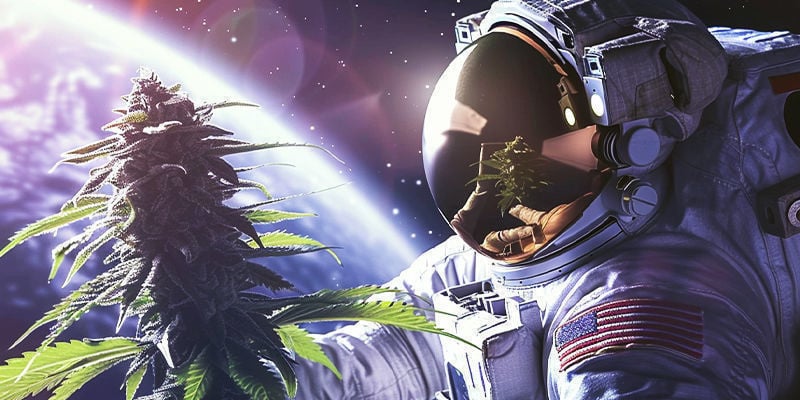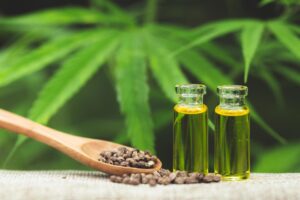Imagine a future where astronauts on Mars harvest fields of tall, fibrous plants under a rusty sky, turning a barren world into a thriving outpost. This isn’t science fiction—it’s the frontier of astrobotany, where Cannabis sativa, commonly known as hemp, is emerging as a star player. Recent missions have catapulted hemp seeds into orbit, testing their resilience against cosmic radiation and microgravity. In 2025, international researchers launched cannabis seeds aboard a SpaceX rocket to study potential mutations that could yield hardier strains for extraterrestrial agriculture. Earlier, in 2019 and 2020, hemp tissues and seeds spent weeks on the International Space Station (ISS), revealing how zero gravity influences gene expression and metabolic pathways. These experiments, backed by companies like Front Range Biosciences and Redwire Corporation, aim to unlock hemp’s potential for sustaining human life beyond Earth. With NASA’s Artemis program eyeing Mars missions, hemp’s versatility— from oxygen production to building materials—makes it a candidate for turning the Red Planet green.
The Harsh Realities of Martian Homesteading
Mars is no gardener’s paradise. Its thin atmosphere, composed mostly of carbon dioxide with scant nitrogen, offers little protection from solar radiation that bombards the surface at levels 2.5 times higher than on the ISS. Temperatures swing wildly, plummeting to -60°C at night, freezing any exposed water. The regolith, Mars’ dusty soil, is laced with toxic perchlorates—chlorine-based salts that can harm plants and humans alike—and lacks essential nutrients like phosphorus and potassium. Low gravity, about 38% of Earth’s, disrupts water flow in soil, leading to root suffocation and uneven nutrient distribution. Without a magnetic field, cosmic rays penetrate deeply, potentially stunting growth or causing genetic damage. Yet, these challenges highlight why resilient crops like hemp are crucial: they could terraform micro-environments in domed habitats or underground farms, recycling resources in closed-loop systems essential for long-duration missions.
Hemp’s Earthly Superpowers: A Blueprint for Survival
On Earth, hemp has earned its reputation as a wonder crop. This ancient plant, cultivated for over 10,000 years, grows rapidly—reaching heights of 4 meters in just 90-120 days—requiring minimal pesticides and thriving in diverse soils. One hectare yields 12-15 tons of air-dried biomass, outpacing many crops in efficiency. Its carbon sequestration is legendary: hemp absorbs 8.9 to 22 tons of CO2 per hectare per crop, potentially doubling with two harvests annually, surpassing forests in speed and volume. Nutritionally, hemp seeds pack a punch—21-28% protein with all essential amino acids, 24-36% lipids rich in omega-3 and omega-6 fatty acids in a 3:1 ratio ideal for human health, and 28-34% fiber for digestive support. These attributes make hemp a multifaceted resource: seeds for food and oil, stalks for fiber, and roots for soil remediation. In space, such efficiency could minimize resupply needs from Earth, where each kilogram costs thousands of dollars to launch.
Breathing Life into the Void: Oxygen and Purification
Life support on Mars demands reliable oxygen sources and air purification. Hemp excels here through photosynthesis, converting CO2 into oxygen at rates competitive with other crops. In enclosed habitats, a hemp farm could recycle astronauts’ exhaled CO2, producing enough oxygen to sustain crews while scrubbing toxins. Studies show hemp’s rapid biomass accumulation enhances this process; for instance, it sequesters more CO2 per hectare than trees, aiding in climate control within Martian greenhouses. Moreover, hemp’s phytoremediation abilities—absorbing heavy metals and salts from soil—could detoxify Martian regolith over time. Redwire’s upcoming ISS greenhouse experiment will grow hemp from seed to maturity, analyzing gene expressions for optimized oxygen yield in microgravity. This could integrate with water reclamation systems, where hemp’s transpiration recycles moisture, creating a self-sustaining biosphere bubble amid Mars’ desolation.
Nourishing Astronauts: A Seed of Sustenance
Food scarcity poses a dire threat on Mars, where shipments from Earth take months. Hemp seeds offer a compact, nutrient-dense solution: a single plant produces hundreds of seeds, providing complete proteins comparable to soy or quinoa, with added vitamins like E and minerals such as magnesium and iron. In space diets, this could combat muscle atrophy and boost immunity, especially since omega fatty acids support brain health during isolation. Experiments on the ISS have shown hemp cultures mutating in ways that might enhance nutritional profiles, like higher CBD for stress relief—vital for astronauts facing PTSD risks on long missions. Ground-based simulations using Mars regolith analogs suggest hemp can yield viable crops with amendments, providing calories (around 500 per 100g of seeds) and versatility for oils, milks, or flours. By rotating with other plants, hemp could ensure dietary diversity, turning Martian farms into bountiful larders.
Constructing the Red Frontier: Hemp as Building Material
Shelter on Mars must withstand radiation, dust storms, and thermal extremes. Enter hempcrete—a mixture of hemp hurds, lime, and water—that’s lightweight, insulating, and mold-resistant. Recent research blends hemp fibers with Martian regolith to create “hemp-fiber concrete,” boosting flexural strength by up to 20% and improving thermal conductivity for better heat retention. This in-situ resource utilization reduces launch mass; astronauts could grow hemp, harvest fibers, and 3D-print habitats. Hempcrete sequesters CO2 during curing, potentially offsetting emissions from construction. Fibers also yield ropes, textiles, and even biofuels, supporting everything from clothing to energy needs. In finite element analyses, these composites endure Martian loads, paving the way for sustainable domes or underground vaults.
Adapting the Green Giant: Overcoming Space Hurdles
Despite its promise, hemp faces adaptation challenges. Radiation exposure might induce beneficial mutations, as seen in 2025 orbital tests, creating strains tolerant to low nitrogen or cold snaps. Hydroponic or aeroponic systems could bypass toxic soil, with LED lights mimicking sunlight for year-round growth. Genetic engineering, informed by ISS data, may enhance drought resistance—vital since Mars’ water is locked in ice caps. Pests and diseases amplify in confined spaces, but hemp’s natural resilience minimizes risks. Collaborative efforts, like those in South Africa’s space industry, explore hemp’s role in quality management and sustainable development for cosmic endeavors.
The Cosmic Harvest: Hemp’s Path to Martian Legacy
As humanity eyes Mars colonization by the 2030s, hemp stands poised to bridge Earthly ingenuity with extraterrestrial necessity. From sequestering CO2 to fortifying structures, its facts-backed benefits—high yields, superior nutrition, and eco-friendly materials—could sustain pioneers. While challenges persist, ongoing space experiments illuminate a future where Cannabis sativa not only supports life on Mars but redefines sustainable exploration. The seeds are sown; now, we watch them grow toward the stars.
Imagine stocking shelves with hemp products engineered for tomorrow’s frontiers—straight from the labs that inspired Martian life support. At NanoHempTechLabs, our wholesale line harnesses Cannabis sativa’s superpowers: nutrient-dense seeds for premium edibles, resilient fibers for eco-textiles, and CO2-sequestering biomass for sustainable packaging. Backed by orbital experiments showing 20% stronger composites and rapid 90-day yields, our nano-enhanced formulations deliver unmatched purity and efficacy—absorbing 22 tons of CO2 per hectare while boosting omega-rich nutrition.
Elevate your brand with wholesale exclusivity: bulk pricing on oils, proteins, and fibers that terraform retail success. Schedule a call today to unlock cosmic-scale opportunities!
Reference:
- Augustyńska-Prejsnar, A., Topczewska, J., Ormian, M., & Sokołowicz, Z. (2022). Quality of poultry roast enriched with hemp seeds, hemp oil, and hemp flour. Foods, 11(23), 3907. https://doi.org/10.3390/foods11233907
- Capcanari, T., Covaliov, E., & Negoița, C. (2024). Hemp (<i>cannabis sativa</i> l.) seeds nutritional aspects and food production perspectives: a review. Food Systems, 7(1), 52-58. https://doi.org/10.21323/2618-9771-2024-7-1-52-58
- Cheng, D., Woo, J., Şimşek, Ş., & Wang, W. (2025). Elucidating the potential of dietary hemp seed on gut health: recent advances and future perspectives. Food Chemistry International, 1(2), 102-109. https://doi.org/10.1002/fci2.70011





